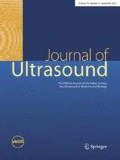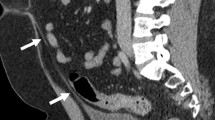Abstract
Purpose
Over the past two decades, continuous ambulatory peritoneal dialysis has emerged as the first-choice dialysis modality in children awaiting for transplantation. Despite the improvements observed in catheter survival over the past several years, the obstruction is one of the reasons for immediate catheter non-function. This study assessed usefulness of ultrasound (US) in visualizing the obstruction of chronic peritoneal dialysis (CPD) catheter and identifying the etiology.
Materials and methods
Between January 2000 and November 2012, 38 patients (20 M, 18 F) were treated with CPD and examined with US. The type of catheter in all subjects was the straight two-cuff Tenckhoff catheter. We evaluated the typical sonographic signs of the most common CPD catheter complications.
Results
We had 12/38 cases with catheter malfunction due to its obstruction. In eight patients, US showed the presence of echogenic material fragmented into the lumen and around the distal tip of the catheter. In the other four patients, US demonstrated the displacement of catheter in bowel loops and an amorphous material as homogeneous echoic area around the distal tip.
Conclusions
Our results confirm the effectiveness of US in the assessment of the complications related to intraperitoneal catheters. US is able to identify the catheter obstruction and recognize the etiology (endoluminal strands of fibrin, other materials or the omental wrapping), facilitating a correct therapeutic approach.
Riassunto
Obiettivo
Nel corso degli ultimi due decenni la dialisi peritoneale èemersa come modalità di dialisi di prima scelta nei bambini in attesa per il trapianto. Nonostante i miglioramenti osservati nella sopravvivenza nel corso degli ultimi anni,l’ostruzione è uno dei motivi di mancato funzionamento. Scopo dello studio è valutare il ruolo dell’ecografia nell’identificare condizioni patologiche ostruttive catetere-correlate, nella popolazione pediatrica, identificandone la causa eziologica.
Materiali e Metodi
Dal Gennaio 2000 e Novembre 2012 abbiamo valutato periodicamente un gruppo di 38 pazienti (20 M, 18 F) sottoposti a dialisi intraperitoneale e monitorizzati con esame ecografico. Il catetere utilizzato era del tipo Tenckhoff dritto a due cuffie. Abbiamo valutato i segni ecografici tipici delle più comuni complicazioni ostruttive correlate al catetere per dialisi peritoneale.
Risultati
Abbiamo documentato 12/38 casi di malfunzionamento del catetere su base ostruttiva. In otto pazienti, l’ecografia documentava la presenza di materiale ecogeno frammentato nel lumeed intorno alla punta distale del catetere. In altri quattro pazienti, l’ecografica documentava l’intrappolamento del catetere in anse intestinali ed un materiale amorfo omogeneamenteecogeno intorno alla punta distale.
Conclusioni
I nostri risultati confermano l’efficacia dell’ecografia nel rilevare complicanze ostruttive catetere-correlate. L’ecografia ha permesso di riconoscere non solo la presenza dell’occlusione del catetere ma di discriminarne l’eziologia riportando elementi utili per distinguere fra deposizione di materiale fibrotico ed incarceramento del catetere da parte di aderenze peritoneali con adesione dell’omento ai fori o scivolamento nel lume del catetere, orientando per un corretto approccio terapeutico.






Similar content being viewed by others
References
Aksu N, Yavascan O, Anil M et al (2007) A ten-year single-centre experience in children on chronic peritoneal dialysis–significance of percutaneous placement of peritoneal dialysis catheters. Nephrol Dial Transplant Off Publ Eur Dial Transpl Assoc Eur Ren Assoc 22:2045–2051
Harshman LA, Neuberger ML, Brophy PD (2012) Chronic hemodialysis in pediatric patients: technical and practical aspects of use. Minerva Pediatr 64:159–169
Rinaldi S, Sera F, Verrina E et al (2004) Chronic peritoneal dialysis catheters in children: a fifteen-year experience of the Italian Registry of Pediatric Chronic Peritoneal Dialysis. Perit Dial Int J Int Soc Perit Dial 24:481–486
Macchini F, Valadè A, Ardissino G et al (2006) Chronic peritoneal dialysis in children: catheter related complications. A single centre experience. Pediatr Surg Int 22:524–528
Furth SL, Donaldson LA, Sullivan EK, Watkins SL (2000) Peritoneal dialysis catheter infections and peritonitis in children: a report of the North American Pediatric Renal Transplant Cooperative Study. Pediatr Nephrol (Berl Ger) 15:179–182
Yang P-J, Lee C-Y, Yeh C-C et al (2010) Mini-laparotomy implantation of peritoneal dialysis catheters: outcome and rescue. Perit Dial Int J Int Soc Perit Dial 30:513–518
Ogunc G (2005) Minilaparoscopic extraperitoneal tunneling with omentopexy: a new technique for CAPD catheter placement. Perit Dial Int J Int Soc Perit Dial 25:551–555
Nicholson ML, Burton PR, Donnelly PK et al (1991) The role of omentectomy in continuous ambulatory peritoneal dialysis. Perit Dial Int J Int Soc Perit Dial 11:330–332
Debono Retienne et al (2012) The use of ultrasound in the diagnosis of Tenckhoff catheter tunnel infection. Malta Med J 24(02):39–41
Kwan TH et al (2004) Ultrasonography in the management of exit site infections in peritoneal dialysis patients. Nephrology 9(6):348–352
Balaskas EV, Ikonomopoulos D, Sioulis A et al (1999) Survival and complications of 225 catheters used in continuous ambulatory peritoneal dialysis: one-center experience in Northern Greece. Perit Dial Int J Int Soc Perit Dial 19(Suppl 2):S167–S171
Esposito F, Di Serafino M, Sgambati P et al (2012) Ultrasound in the diagnosis of peritoneal catheter obstruction in children. Kidney Int 82:499
Acknowledgments
The authors would like to thank Dr. Anna Ambrosio for his contribution to the preparation of the manuscript.
Author information
Authors and Affiliations
Corresponding author
Ethics declarations
Conflict of interest
The authors declare that they have no conflict of interest.
Ethical standard
All procedures followed were in accordance with the ethical standards of the responsible committee on human experimentation (institutional and national) and with the Helsinki Declaration of 1975, and its late amendments.
Human and animal rights
This study does not contain any studies with human or animal subjects performed by any of the authors.
Informed consent
Additional informed consented was obtained from all patients for which identifying information is not included in this study.
Rights and permissions
About this article
Cite this article
Esposito, F., Di Serafino, M., Ambrosio, C. et al. Chronic peritoneal dialysis in children: the role of ultrasound in the diagnosis of peritoneal catheter obstruction. J Ultrasound 19, 191–196 (2016). https://doi.org/10.1007/s40477-016-0209-2
Received:
Accepted:
Published:
Issue Date:
DOI: https://doi.org/10.1007/s40477-016-0209-2




